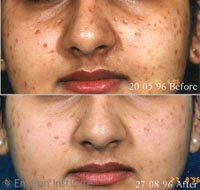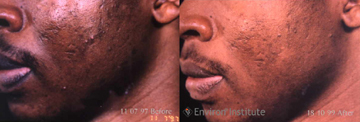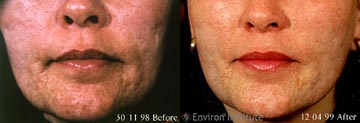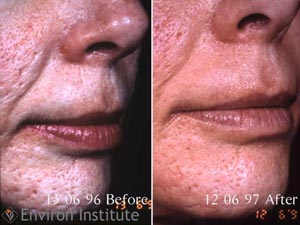
Treating Damaged Skin
By Dr. Des
Fernandes
Iontophoresis
There
has been a resurgence of interest in iontophoresis in the medical
profession. Why call it a renaissance of iontophoresis in this day and
age? We've known about galvanic current for about 200 hundred years and
iontophoresis (a word derived from Greek meaning the transport of
electrically charged chemicals called ions) through skin was demonstrated
almost 100 years ago.
Skin care therapists have used galvanic
currents to treat skin for about 70 years -so what can be new? First
activate the skin on negative current, then massage and finally soothe the
skin on positive for a refreshed appearance. Right? No! Wrong!
Of
course these ideas are wrong because they ignore the basic scientific
principles. First of all one has to understand that iontophoresis will
only occur if the targeted active chemicals have an electrical charge
(i.e. they are ions carrying either a positive or negative electrical
charge, or will ionise with electricity). When a low intensity galvanic
current is applied to a molecule that can dissociate into a positive ion
(cation) and a negative ion (anion), then it dissociates more readily in
the presence of water and salts. Negative ions move towards the positive
pole, and positive ions move towards the negative pole. As a result ions
can be carried to deeper layers of the skin and concentrated
there.
If a positive current is applied to the skin together with
appropriate gels, then the positive pole will act exactly like a magnet
(North Pole repels North Pole and alternately South Pole and vice versa)
and repel cations and attract anions. Therefore, if one wants to
facilitate the penetration of a cation then one has to apply a positive
charge to the skin. However, if one wants to make an anion penetrate
deeper into the skin, then one has to apply a negative charge.
To
understand iontophoresis better, then one must go back to the very first
demonstration of its power. Two rabbits were selected and one poison that
has a positive charge was applied to one ear and a poison with a negative
charge was applied to the other ear. Only one ear was treated with an
electrical current. When the positively ionised poison was treated with a
negative current, nothing happened. When positive current was used then
the rabbit died! So either positive current was responsible, or the
positive poison ions moved through the skin into the blood and killed the
rabbit. The second rabbit then proved that it was the ions because when a
positive current was used, nothing happened, whereas when a negative
current was used, the rabbit died! The only explanation was that the
positive and negative ions had been repelled by their similar charges and
had gone through the skin.
This was a magnificent demonstration but
unfortunately not enough people paid attention to it and it was lumped
together with things like hypnosis and ignored by the medical profession.
In recent years, research workers have looked again at iontophoresis and
have tried to define its mysteries. As a result we've learned a great deal
about iontophoresis and today research workers believe that iontophoresis
can very often be as effective as injections into the skin or muscles.
Diabetics may one day wear only a simple instrument like a watch and in
that way dose themselves with enough insulin to keep them selves healthy.
Other powerful medicines can even be taken more than 2 cms. Into the body
by simple electrical currents. Iontophoresis promises to become a major
method for treating people without the use of injections and other
invasive techniques. The research workers have realised that we have to
know certain properties about ions, not merely that they can ionise. When
a molecule that can be ionised at an appropriate pH is subjected to a
galvanic current, the molecule ionises into its anion and cation. We have
learned that the concentration of the ions is important. The strongest
solution is not always the best. We also know now that the properties of
the current are important. Certain wave shapes and intermittent
application of the current are better than continuous galvanic current.
There are some very important rules that have to be followed when doing iontophoresis.
- The selected molecule must be ionised into positive and
negative components and be maintained as ions during the treatment. You
cannot iontophorese chemicals that are not ionised.
- The size of the ion is important. For example even though a complex
protein like collagen may be possible to ionise, the size of the
important ion of collagen is so large that it cannot be transported
through skin.
- There is a limit to the number of polar substances that can be used
simultaneously. We believe that during iontophoresis "pores" open up
through membranes and the charged particles can move through them. If
there are too many charged particles then the "pores" may be "blocked"
by the crowd of ions converging all at once.
- The ion must be water-soluble because electricity is only conducted
through water and not lipids.
- The pH of the active gel is of fundamental importance. The right
ingredient at the right concentration won't work properly if the pH is
wrong. Each ion has it's own ideal pH at which it will be ionised
best.
- The current used must be appropriate. You cannot use
any current you like.
- The current used should be high enough to be effective
and still safe. The higher the current, the faster the ions will
move.
- Intermittent current works better than continuous
current because as the ion moves into the skin it will react with other
chemicals and needs to be re-ionised. I have used the Environ® Ionzyme
DF 1998 machine for the work that I have done.
- The treatment period should be at least 10 minutes and probably not
longer than 30 minutes. Most of the ions pass through the skin at about
8 to 15 minutes and then relatively little passes through after 30
minutes. I prefer to use a "field" of electrical charge rather than use
rollers which produce rather localised effects. I use a specialised
gauze that retains moisture (Hazegauze®) more effectively than any other
gauze I have used.
- It is possible, maybe even highly desirable to treat
skin with only one polarity. It is not necessary to treat the skin with
the opposite current after doing the active treatment. If you do that
then you will reverse the beneficial effects of the active
treatment!
- Of course, the ion will only have positive effects if in fact scientific research has proved that it is effective. Ionising salt water into skin cannot have the same effects as ionising a proven rejuvenating vitamin ion into the skin.
We are also learning about electro-osmosis which is closely allied to
iontophoresis. In this case, ions move along the electrical
"concentration" gradient i.e. from a high current to a low current.
Another intriguing phenomenon is electro-poration. By this we mean the
"holes" created in membranes by electrical current which then allow non
ionised molecules to pass through the membranes.
iontophoresis when
correctly used is proving to a be a powerful tool. However, it does have
problems. First of all it can only used on molecules that can be ionised.
Not all molecules can be ionised at physiological levels and some cannot
be ionised. Secondly, if strong currents are used and the current us built
up too quickly when using simple galvanic current, then a burn may occur.
One has to remember that in fact some very complex chemical changes occur
at the exact site of the iontophoresis contact points. Strong alkalis may
be formed or strong acids may damage the skin.
Modern iontophoresis has
been used to minimise wrinkles, to eliminate pigment blemishes, soften
scars and normalise skin. However, this only happens when the gels used
contain the right ingredients, at the right pH, with the right
concentration, treated with the correct current properties for the correct
amount of time. Change only one of these important points and the
treatment becomes a simple complex manipulation of skin and the clients
purse.
With properly controlled iontophoresis up to 400% better
penetration can be achieved under ideal conditions and the improvement of
skin can be hastened quite dramatically.


Sonophoresis has the advantage that the compounds do not have to be ionised. The best explanation for the movement through skin seems to be explained as cavitation of the skin cells and membranes. This process of cavitation occurs during the treatment but these cavities disappear after the treatment and histological examination of the skin has shown that the skin is normal after the treatment. These may in fact be the same pores as are induced by iontophoresis. Mitragotri has shown that contrary to expectation, cavitation of the skin occurs better the nearer one is to audible sound. In fact in the range of the sounds that dolphins emit their sonic messages, we get the best cavitation and penetration of molecules through skin. This range is at most only 10% of the sound that is used in conventional ultra-sound machines. Mitragotri has described that with sonophoresis he could get about 4000% better penetration after five minutes of sonophoresis at 20 KHz than with topical application.



All rights reserved. No part of this website may be reproduced or transmitted in any form without written permission from Chez Blanc